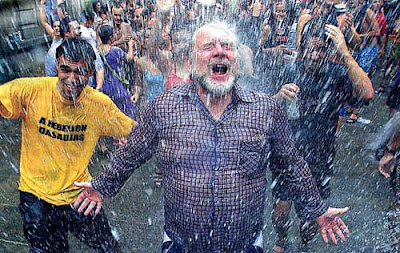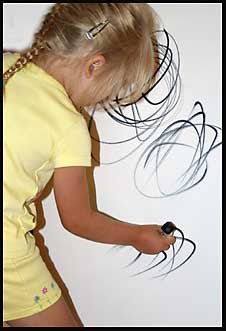>Originally posted September 18, 2007.

Part one of the Situationism series can be found here.
In addition to this you may want to read about Oswald Spengler as well, here (English) and here (Swedish).
—
(Anonymous graffiti, Paris 1968)
Raoul Vaneigem, The Revolution Of Everyday Life
The situationist movement was at its peak in the late sixties, but kind of folded after the riots and shit that were trendy at the time. Their ideas live on, though. And mind you, I’m not that much into their art – or anti-art – since most of the times it just sucks. It’s their ideas that I like.
Having concluded that the art and culture of bourgeois society was intellectually fucked, doomed to repetition and soulless, meaningless activities, the situationists referred to art as something that truly could change peoples lives and their way of thinking.
Art to them was not just something to feed the senses for a while, making you feel good and momentarily happy. That way of looking at art is shallow. In the eyes and mind of Guy Debord, art was revolution. Art was war. War against the everyday madness, the everyday slaughter of the soul. Most of all, art was real and goddamn important, and the situationists were determined to see through the lies, myths and bullshit that is being thrown at us every single second of our lives.
“It was about the radiation of art into pure existence, into social life, into urbanism, into action and into thinking which was regarded as the important thing”, as stated in the book Situationister i konsten (1966). Art wasn’t supposed to be a useless medium.

So what do you get when you mix art with politics?
Street art, of course. It’s available for free for everyone to see, and the creator is most of the times totally anonymous. We cannot judge the art and the message by who the creator is, but rather by what the message constitutes and how it is executed. True art. True politics. No names, no games. Well, names in a way, since there’s usually a tag attached somewhere, but close to nobody knows the person behind the tag, and that’s what’s fascinating about graffiti. It’s the deed and action that counts, not who’s done it.
No gods, no masters.
 Banksy at the separation wall in Israel/Palestina
Banksy at the separation wall in Israel/Palestina
 Banksy at the separation wall in Israel/Palestina
Banksy at the separation wall in Israel/Palestina
However, street art to me is not about reclaiming the streets. Well, it is in a way, but since Reclaim The Streets today seem to equal mindless destruction executed by degenerated fuck ups with nothing better to do, I strongly reject that kind of “reclaiming”. And I bet most of the serious situationists of the 60’s would’ve done so too. Such behaviour is nothing but fake and I spit blood on their useless corpses.
The long revolution is creating small federated microsocieties, true guerilla cells practising and fighting for this self-management. Effective radicality authorises all variations and guarantees every freedom. That’s why the Situationists don’t confront the world with: “Here’s your ideal organisation, on your knees!” They simply show by fighting for themselves and with the clearest awareness of this fight, why people really fight each other and why they must acquire an awareness of the battle.
Raoul Vaneigem, The Revolution Of Everyday Life
it’s about mindless scribbling on walls.
On a sidenote:
Scribbling is for children (and adults!), and we should strongly encourage them here. Marvin Bartel has written an essay entitled “Working with children who scribble on walls” here. You should read it! And when reading, try to relate to graffiti…

Debord et al argued that the great Spectacle, the world’s greatest soap opera, is so influental that not only does it superficially bomb us with commercials, but it possesses such power that it shapes almost all human life (this Spectacle being a small ruling minority dominating the masses, forcing the individual only to consume and participate in society as an alienated, passive idiot).
In this consumer’s society, everything is always “getting better and better”. There’s no end to perfection. Just think about it; how will Gillette’s razor blades look in a year or two? Like a rocket ready to be sent into outer space? It seems like they’re inventing a new revolutionary shaving system every year.

When will this madness end? Not until we say so. And that’s where the passive idiot thing enters the scene. The Spectacle is by no means a dialogue. It is in fact the exact opposite – a monologue, talking to itself, about itself. And as we all know, opposition (for example, in the form of street art) is not looked upon with keen eyes. This artificial “evolution” of Gillette’s shaving systems is a lethal blow to our own evolution. We’re trapped and cannot evolve at all. The situationists labelled this forced existence “a colonization of our everyday lives”.
In a future post I’ll probably write something about the situationist critique against urbanism, which in some ways touches upon what Spengler had to say about cities and such.

